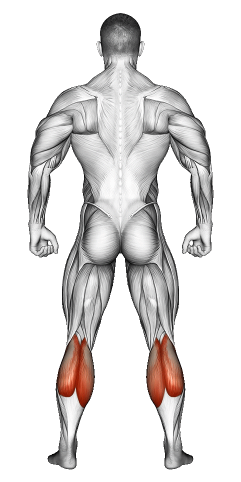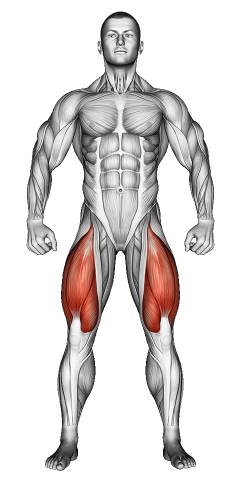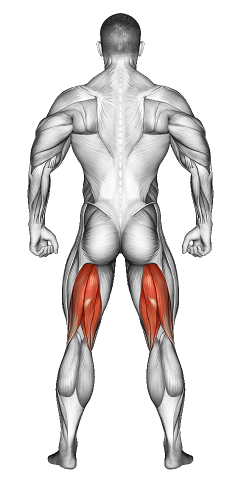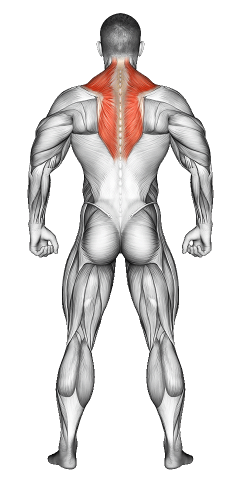Jump Rope: Video Tutorial & Exercise Guide

Written By: Claude Michael
Updated: Jan 14, 2025
| Workout | Jump Rope |
| Primary Muscle Group | Calves |
| Secondary Muscle Group | Quads, Hamstrings, Shoulders |
| Equipment Required | Jump Rope |
| Force Type | Bodyweight |
| Mechanics | Full Body/Cardio |
| Exercise Type | Cardiovascular Endurance |
| Difficulty | Beginner to Advanced |
Jump Rope: Video Tutorial & Exercise Guide
Secondary Muscles Group
Jump Rope: Step-by-Step Guide
- Step 1: Set Up Your Position » Stand upright with your feet togClaude. Grab the jump rope handles with a firm grip, one in each hand. Keep your elbows close to your body, and relax your shoulders. Stand tall but stay light on your feet, ready to jump. Picture the rope clearing your toes with each jump to keep your rhythm.
- Step 2: Start the Movement » Spin the rope by moving your wrists in small rotations. Let your wrists, not your arms, drive the rope. Build momentum with the rope, getting ready to time your jumps with each spin. Keep a steady, moderate speed to stay in control.
- Step 3: Take Your First Jump » As the rope spins smoothly, jump just high enough to clear it. Land gently on the balls of your feet with your knees slightly bent. Keep your jumps low. Don’t jump too high; it wastes energy and slows down your rhythm.
- Step 4: Find Your Rhythm » Stay steady and let the rope guide your jumps. Relax your upper body and focus on light, quick hops. Keep breathing naturally, exhaling as you jump and inhaling as you land. This helps you maintain endurance and keeps you moving longer.
- Step 5: Keep It Consistent » Stay focused on your form and rhythm. As you get tired, focus on relaxing your shoulders and keeping your jumps low. Remember, maintaining control helps you jump longer. Take breaks when you need them.
Jump Rope: Overview
Jumping rope gives you a strong cardiovascular workout, working multiple muscles at once. You’ll feel your calves, shoulders, and core working, plus you’ll build coordination, endurance, and balance. whether you’re a beginner or advanced, you can always make it challenging. It’s a great, flexible workout.
Jump Rope: Benefits
Jumping rope builds endurance, coordination, and balance. You work your calves, shoulders, and core while boosting your heart rate and burning calories. Consistent practice improves cardiovascular health, muscle tone, and agility, and helps with weight management
Jump Rope: Pro Tips & Advanced Techniques
- Focus on Wrist Control: Keep your wrists driving the rope, not your arms. This saves energy and prevents shoulder fatigue.
- Keep Jumps Low: Jump just high enough to clear the rope. Keeping your jumps small helps you go longer.
- Use a Weighted Rope for Strength: When you’re ready, use a weighted rope to build more strength in your arms and shoulders.
- Pace Your Breathing: Keep a steady breathing pattern. Exhale with each jump to stay in rhythm and controlled.
Jump Rope: Progression Plan
Beginner
Intermediate
Advanced
Jump Rope: Frequently Asked Questions (FAQs)
What muscles does jumping rope work?
+Jumping rope works your calves the most, but you’ll also feel it in your shoulders, core, and forearms as you control the rope.
Can I add jump rope to any workout?
+Yes! Use it as a warm-up, cardio finisher, or even as a full workout. It’s a great cardio boost and can fit into any fitness plan.
Is jump rope good for weight loss?
+Yes! Jumping rope burns calories fast, helping with weight management, especially when combined with a balanced diet and strength exercises.
How often should I jump rope?
+Aim for 2-3 times per week to build endurance and cardio fitness. Pay attention to how your calves feel and give them time to recover.
What mistakes should I avoid?
+Avoid jumping too high and relying on your shoulders for spinning. Keep your jumps low and use your wrists to spin the rope. Stay light and controlled for the best results.
Share
Don’t Wish for It, Work for It – Join the FlexXP Newsletter Today!
Thank you for signing up for the FlexXP Newsletter!
This site is protected and the Google Privacy Policy and Terms of Service apply.



